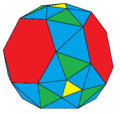| Rectified truncated tetrahedron | |
|---|---|
 | |
| Faces | 20: 4 equilateral triangles 12 isosceles triangles 4 hexagons |
| Edges | 48 |
| Vertices | 12+18 |
| Schläfli symbol | rt{3,3} |
| Conway notation | atT |
| Symmetry group | Td, [3,3], (*332), order 24 |
| Rotation group | T, [3,3]+, (332), order 12 |
| Dual polyhedron | Joined truncated tetrahedron |
| Properties | convex |
| Net | |
 | |
In geometry, the rectified truncated tetrahedron is a polyhedron, constructed as a rectified, truncated tetrahedron. It has 20 faces: 4 equilateral triangles, 12 isosceles triangles, and 4 regular hexagons.
Contents
Topologically, the triangles corresponding to the tetrahedron's vertices are always equilateral, although the hexagons, while having equal edge lengths, do not have the same edge lengths with the equilateral triangles, having different but alternating angles, causing the other triangles to be isosceles instead.







